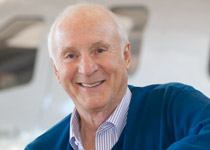Last month I wrote about the joy of flying various types of aircraft, an avocation to which I refer as "type collecting." A Gulfstream III captain, Joe McGuire, wrote to tell me that he collects destinations. He says that he has flown to every state, 61 countries, and four U.S. territories. He also has flown once around the world.
He has me beat on most counts. I have never touched down in either North Dakota or South Carolina, and I have landed in only 45 countries and two U.S. territories. I have him beat, however, with respect to flights around the world. I have proven to myself a dozen times that the Earth is not flat (eastbound and westbound).
McGuire's e-mail prompted me to wonder how many airports I have visited. I have no idea. Counting them would require sifting through 48 years' worth of logbooks and require more time and effort than I can afford. Then I wondered what might be the greatest number of airports visited by any given pilot. Could it be a thousand? It might be fun to start a "500 Airport Club" or whatever number might be appropriate.
Dusting off my logbooks and flipping through the yellowing pages to count airports also would uncover the names of many that are no more, airports that fell victim to the bulldozer and were replaced with shopping malls, business parks, and housing tracts. I can think of many that were within a short drive of home here in California but now are only fond memories. These include the 6-S Ranch, Glendale Municipal, Conejo Valley, Hughes, Culver City, Santa Susana, Meadowlark, Del Mar, and others.
In sharp and frightening contrast, I can recall only one new airport having been built in Southern California during my entire flying career. This was French Valley Airport, built to replace nearby Temecula, a victim of urban expansion.
Following a speech I gave to the Mid-Atlantic Aviation Coalition last June, a few members drove me the next day to where the airport serving my hometown used to be (near New Brunswick, New Jersey). I had spent many pleasant hours there instructing air scouts in Piper J–3 Cubs. This was when TWA assigned me, a new-hire Lockheed Constellation copilot, to its New York domicile. A Holiday Inn and a shopping center had displaced Hadley Field, and a plaque imbedded in stone near the front of the motel was the only reminder of this historic site.
It frightens me to think of all the airport closures. An airport closed is an airport gone forever. Think about owning an airplane and having nowhere to fly it.
I also received an e-mail from Chuck McGill, a flight instructor from San Diego. He told me about his plan to land at every public airport in California in his 150-horsepower Cessna "150/150," Herbie. His reason? "Because." Perhaps his flight would be a celebration of airports. It sounds challenging and lots of fun. Logging the hundreds of flights also would be challenging. Just imagine how many pages of his logbook they would fill.
Other pilots have done similar things such as flying to the airport serving every state capital or to 48 or 50 airports that would represent a landing in every state.
A landing obviously represents the end of a flight and usually brings about a sense of having met the journey's challenge with safety and enjoyment. But there is also something of a magic-carpet aspect to touching down on new turf. We step out of our aircraft anticipating the discovery of a new world. This is why many of us deplane, stretch, take a deep breath to sample the atmosphere, and spend a moment or two soaking up the ambiance and admiring the new vista before attending to the medial, ground-bound chores of tying down and arranging for transportation.
Every runway stretches in two directions like a pair of open arms inviting the aviator to the community it serves. And we usually are made to feel welcome upon arriving at a new airport. We meet and are befriended by others who share our love of flight, some of whom are among the most delightful characters I have ever met.
I have become a dedicated and proficient ramp rat, and one of my favorite pastimes is walking the line at a new-to-me airport and gawking at the aircraft parked there. I am especially amused by the taildraggers. Parked nose high, they always seem to be sniffing the air, poised for flight. They rock gently in the breeze and—without my bestowing upon them an anthropomorphic quality—seem to be attempting to escape their shackles and take to wing. Airplanes with nosewheels don't do that.
I also enjoy peering in hangars to see what surprises and treasures are hidden within their corrugated metal structures.
When I fly cross-country in my near-new American Champion Explorer (nee Citabria 7GCBC) I typically fly low. This not only gives me a better view of the terrain but also makes it easier to drop in on enticing airports that pop up along the way. I am particularly attracted to grass strips shimmering in sunlight and those surrounded by unusual or appealing topography.
Only other pilots understand when I say that an airport is like a second home. It should come as no surprise that I can never turn down a request to donate money and energy to save endangered landing places. I take an attack against an airport as something very personal.
I hope that you do, too.
Contact the author at www.barryschiff.com.



